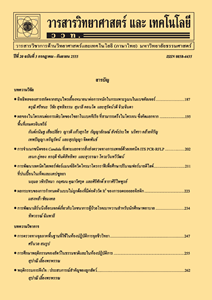Evaluation of Bioaerosols Concentrations in Mushroom, Swine and Poultry Farms: Case of Workers in Warinchamrab, Ubon Ratchathani
Main Article Content
Abstract
This study aims to examine airborne fungi and bacteria in mushroom, swine and poultry farms located in Warin Chamrab, Ubon Ratchathani. Air samples were collected with NIOSH method 0800 BIOAEROSOL SAMPLING (indoor air). The results showed that the maximum fungi concentration in mushroom, swine and poultry farms were 2,938.75, 2,575.58, and 2,245.78 CFU/m3, respectively. The maximum bacteria concentrations were 4,570.08, 2,524.54, and 14,813.51 CFU/m3, respectively. The maximum concentrations of bacteria found in mushroom and swine farms were not more than the suggested level from IRSST (Occupational Health and Safety Research Institute Robert Sauvé) which was 10,000 CFU/m3 in the air for 8-hour working day. However, in the poultry farm, the maximum bacteria concentration was above the suggested level and this might affect the workers’ health. In addition, the isolated fungi and bacteria from the air samples were identified. In mushroom farm, there were 4 genera of fungi, namely Aspergillus spp., Aspergillus niger, Penicillium sp. and Rhizopus sp. and 2 genera of bacteria, namely Bacillus sp. and Staphylococcus sp. In the swine farm, there were 4 genera of fungi, namely Aspergillus spp., Curvularia spp., Penicillium sp. and Rhizopus sp. and 2 genera of bacteria namely Bacillus sp. and Staphylococcus sp. In poultry farm, there were 5 genera of fungi, namely Absidia sp., Penicillium sp., Aspergillus niger, Aspergillus spp. and Fusarium sp. and 2 genera of bacteria, namely Bacillus sp. and Staphylococcus sp. These were associated with respiratory diseases and allergies, especially (such as Penicillium sp. and Aspergillus spp.) in people with hypersensitivity or patients. These might cause asthma, cough, and wheezing. Moreover, exposure to airborne fungi and bacteria at high concentrations might result in reducing lung capacity. The results of this study could be used as a guideline to improve the air quality in the farms. Therefore, monitoring the indoor air quality was suggested to control the number of fungi and bacteria in the farmhouses or agricultural sheds. These would be the way to prevent harm and reduce the cause of illness for workers who expose to airborne fungi and bacteria.
Article Details
References
Phanprasit, W., 2000, Indoor Air Quality Procedure, Health Department, Bangkok. (in Thai)
Occupational Health Documentation, Academic Development Center in Eastern Industrial Zone, Rayong Province, Department of Disease Control, Ministry of Public Health, Available Source: http://www.siamsafety.com, November 1, 2014. (in Thai)
Bowonkitti, S., Srisawai, P., Chanvichit, C., Health Care Articles and Tips for Good Health for Sick Buildings Disease, Available Source: http://www.healthcarethai.com, October 16, 2015. (in Thai)
Prasert, N., 2011, Entomophthoromycosis in mushroom farm workers in Muang district, Ratchaburi province, Week. Epidemiol. Surv. Rep. Ratchaburi Province 42: 74-80. (in Thai)
Sowiak, M., Bródka, K., Buczyńska, A., Cyprowski, M., Kozajda, A. and Szadkowska-Stańczyk, I, 2012, An assessment of potential exposure to bioaerosols among swine farm workers with particular reference to airborne microorganisms in the respirable fraction under various breeding conditions, Aerobiologia 28: 121-133.
Kang, J.H. and Jo, W.K., 2006, Workplace exposure to bioaerosols in pet shops, pet clinics, and flower gardens, Chemosphere 65: 1755-1761.
Goyer, N., Lavoie, J., Lazure, L. and Marchand, G., 2001, Bioaerosols in the Workplace Evaluation Control and Prevention Guide, IRSST Occupational Health and Safety Research Institute Robert Sauvé, Montreal.
Tarigan, Y.G., Chen, R.Y., Lin, H.C., Jung,
C.Y., Kallawicha, K., Chang, T.P., Hung, P.C., Chen, C.Y. and Chao, H.J., 2017, Fungal bioaerosol exposure and its effects on the health of mushroom and vegetable farm workers in Taiwan, Aerosol Air Qual. Res. 17: 2064-2075.
Sowiak, M., Bródka, K., Buczyńska, A., Cyprowski, M., Kozajda, A., Sobala, W. and Szadkowska-Stańczyk, I., 2011, An assessment of potential exposure to bioaerosols among swine farm workers with particular reference to airborne microorganisms in the respirable fraction under various breeding conditions, Int. J. Aerobiol. (DOI: 10.1007/s10453-011-9216-0)
Crook, B., Easterbrook, A. and Stagg, S., 2008, Exposure to Dust and Bioaerosols in Poultry Farming, Summary of Observations and Data, Prepared by the Health and Safety Laboratory for the Health and Safety Executive.
Lee, S.A. and Liao, C.H., 2014, Size-selective assessment of agricultural workers’ personal exposure to airborne fungi and fungal fragments, Sci. Total Environ. 466-467: 725-732.
Thongnern, N., Nakkrai, S., Onkom, N. and Kongcharoen, C., 2016, Spores of Aspergillus fungi, Cladosporium and Penicillium induce asthma with potential in students 10-15 years, Thai Sci. Technol. J. 24(1): 126-138. (in Thai)
Reponen, T., Lockey, J., Bernstein, DI., Vesper, SJ., Levin, L., Hershey, GKK., Zheng, Ryan, P., Grinshpun, S.A., Villareal, M. and Lemasters, G., 2012, Infant origins of childhood asthma associated with specific molds, J. Allergy Clin. Immunol. 130: 639-644.
Wutudomlert, M., The Infections and the Indoor Air Pollution, Available Source: http://www.pharmacy.mahidol.ac.th/th/knowledge/article/116/ Mold - the source of pollutants in the building, October 16, 2012. (in Thai)
Dechamala, P. and Natapinthu, K., 2015, Type and airborne bacteria concentration in the old shop Khon Kaen Municipality, Khon Kaen, J. Dis. Prevent. Control Office 6 Khon Kaen 24(1): 68-77. (in Thai)
Procop, G.W., Church, D.L., Hall, G.S., Janda, W.M., Koneman, E.W. and Schreckenberger, P.C., 2017, Koneman's Color Atlas and Textbook of Diagnostic Microbiology, Jones & Bartlett Learning, Burlington, MA., 1830 p.


